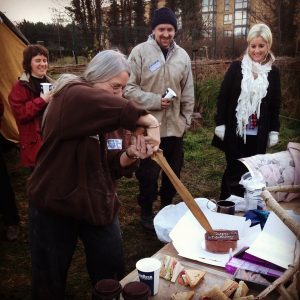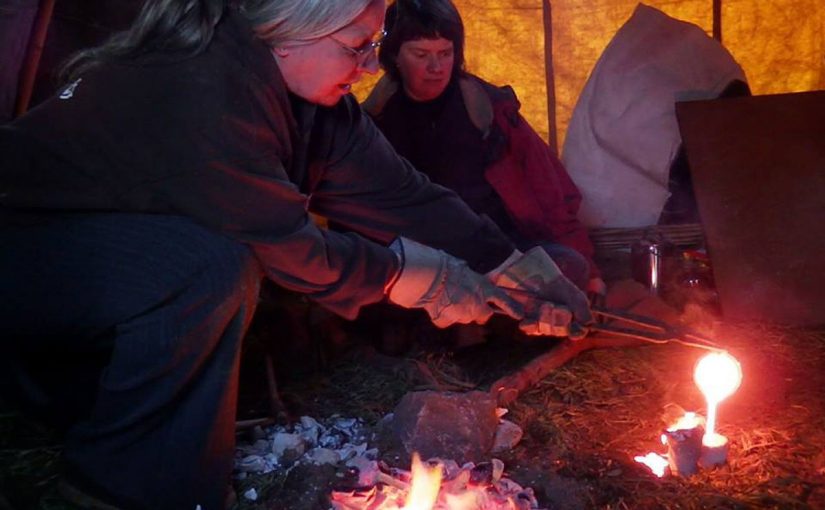I’ve been honoured to cast alongside Billy on a number of occasions while we were both at Umha Aois events. His recent article for the Pallasboy Project: Art, Craft, Archaeology, and Alchemy talks about his experience in both experimental archaeology and craftsmanship.
Tag: Umha Aois
EXARC: 9th Experimental Archaeology Conference, Dublin (IE)
17-18 January 2015
I missed the first day of the conference. Instead I was at my PhD graduation ceremony. It was a wild trip. I graduated with the full regalia of cap and gown, had a quick couple glasses of wine at the archaeology department’s reception, and then we hopped on a fast flight to Dublin for the EAC9 conference at University College, Dublin. The conference was a collaborative effort brought together by EXARC, UCD, and the Irish National Heritage Park. It was a large conference with over 200 delegates, 20 papers, and 31 posters.
The Dublin University campus is huge and spread out, so we had a time trying to find the right building. I arrived just in time to deliver my paper and see the rest of the session. There were some interesting papers and posters given that explored the range of pyrotechnology in archaeology from cremation to glassworking and metalwork. In addition to the usual poster session, individual posters were given a ten minute presentation while being projected in the main hall. These included Jiří Hošek, Ryszard Kaźmierczak, Paweł Kucypera & Maciej Tomaszczyk (Nicolaus Copernicus University) with a presentation on steel carburising in a small shaft furnace, and Yuri Godino & Lorenzo Teppati Losè (University of Florence) presented a poster on their experiments on cupellating galena to produce refined silver.
I was also interested in the presentations on glassworking. There were two very different approaches to the subject with Marta Krzyżanowska & Mateusz Frankiewicz from Poland who spoke about producing Early Medieval lampwork type beads in an open hearth based on excavations in Ribe. Jonathan Thornton from Buffalo, New York spoke about replicating trade bead production based on evidence from Africa using glass frit in a clay mould .
The presentations that discussed metal began with my presentation on inverse segregation and its influence on chemical analysis of objects cast in the Bronze Age. Padraig McGoran of Umha Aois presented a poster on his experiments that included problems and solutions in casting into open one piece moulds.
After that I was off to the university’s experimental grounds to help set up furnaces and get ready for casting. The centre boasts a Mesolithic house, along with metalworking furnaces in varying states of decay. There are separate areas set aside for flint knapping, firing pottery, and active metalworking projects. The members of Umha Aois had already started building a variety of furnaces that included ones heated from below, from the side, and another with a tuyere that had a 90 degree bend that blew the air directly onto charcoal covering a flat, pan-shaped crucible. I worked at a portable ceramic furnace that was brought to the site by Fiona Coffey. It was set up inside Billy Mag Floinn’s newly constructed traveller’s tent. Despite it being wind and waterproof, the flaps ventilated it well and we kept warmer than the others who were set up under a tarp outside.

At lunch I was presented with a birthday cake. Surprisingly no one had anything bigger to cut it with than a pocket knife. The only solution was to get one of Billy’s bronze swords and carefully slice it. It was a most memorable birthday.
Bronze objects that had been created by the members of Umha Aois were on display, including swords, horns, tools, spears, and stone moulds. We spent the day casting axes, jewellery, tools, and more. There was a constant flood of visitors and regular announcements were made when one of us was ready to pour. For most of the day it was standing room only. The casting events continued all afternoon and into the evening.
Rather than head straight back to Sheffield the next day, I had arranged to see the Bishopsland Hoard and a hammer from the Garden Hill Hoard at the National Museum. I’d hoped that I could see some moulds, and to have some colleagues also examine the objects. Unfortunately emails were crossed and I just got to see the hoard and hammer. However, that was fascinating in itself, and I spent hours measuring, weighing, drawing, and photographing every detail of the artefacts.
Events like this are exhilarating and exhausting. We all learn more every time we meet, and we come away with new ideas as well as newly cast objects to finish up. This week I’ve been filing and polishing some of the bronze fibulae I cast and I still need to get to work on the replica I cast of the hammer from the Lusmagh Hoard. Meanwhile, there are more waxes and moulds to make to get ready for casting again.
Click on the link for more information about the conference EXARC: 9th Experimental Archaeology Conference, Dublin (IE)
and here is a moment by moment twitter feed from the conference
